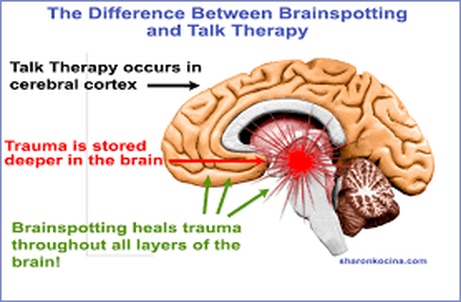Brainspotting
What is brainspotting?
Brainspotting is a mostly nonverbal therapeutic modality that rests on the premise that where we look affects how we feel.
This approach aims to treat unresolved trauma, by engaging the relationship between what we see and what our brain and body experience. Trauma research increasingly shows how trauma “lives” in the body and, over time, changes the structure of the brain.
Brainspotting involves looking around a room and noticing which visual cues are upsetting, and using this information to resolve trauma deep in the brain. Unlike talk therapy, which relies on the brain’s cognitive understanding to process its experiences through language, brainspotting primarily engages the “deep brain” and its unconscious processes.
Brainspotting is typically a short-term therapy, and as few as a handful of sessions may prove effective.

What are the goals of treatment for Brainspotting?
Brainspotting has three primary goals:
- Identify triggers, or stimuli that remind the client of their trauma, perhaps unconsciously, and upset them as a result.
- Explore why these triggers produce the result they do, by thinking through the significance they hold to past traumas.
- Release the trigger by reprocessing the trauma memory and allowing for a new, less upsetting understanding in its place.
How does Brainspotting work?
“Brainspots” are the eye positions that correlate to the part of the brain where a traumatic memory is stored. By working with these brainspots, a client can unleash and resolve trauma in a nonverbal way.
To locate the brainspot, a therapist will invite the client to look around the room. They may use a pointer to track the client’s eyes through their field of vision. When the client has reached their brainspot, the therapist may notice the client twitch, change their breathing, yawn, blink, or change their facial expression.
At this point, the client has reached their brainspot: The place in their field of vision that corresponds to the place in their brain where the distressing trauma is being buried.
Once the client has found the brainspots that bring them distress, the therapist guides them through a series of nonverbal experiences intended to process the trauma and ultimately reduce their distress. These often involve bilateral sound (hearing different sounds in each ear to engage the two hemispheres of the brain), which is designed to enhance the brain’s processing abilities.
Brainspotting can be used as a stand-alone treatment or in combination with other forms of treatment, and has been used in conjunction with chiropractic, acupuncture, and physical therapy.
How effective is Brainspotting?
Brainspotting is relatively new (it was developed in 2003) and the body of research studying its efficacy is still growing. It uses similar nonverbal trauma-processing techniques as Eye Movement Desensitization and Reprocessing (EMDR), which is older, more established, and more backed by scientific research.
Unlike other trauma therapies that rely on crafting trauma narratives and revisiting the trauma, Brainspotting is designed to allow the client to process painful traumatic memories without feeling highly aroused; indeed, many report that Brainspotting can feel calming rather than distressing.
How is a typical brainspotting session structured?
A typical Brainspotting session begins with the therapist using a pointer to work with the client to find brainspots. Clients’ brainspots are generally unknown to them, and their recognition of them may be completely unconscious.
Once the therapist and client have located a brainspot (individuals can have more than one), the therapist has them focus on the brainspot and guides them through a recording of bilateral sounds. Through this process, the trauma is observed, processed, and released, primarily through unconscious means.
What mental health conditions is Brainspotting helpful for?
Brainspotting was originally developed for work with post-traumatic stress disorder (PTSD), but has been used for the treatment of a wide variety of psychiatric disorders, including ADHD and ADD, substance use disorders, depression, and anxiety disorders.
In addition to the treatment of psychiatric conditions, Brainspotting has been used to improve athletic and academic performance, increase creativity, and improve public speaking skills.

